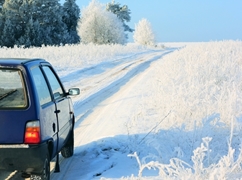
Winter can be a beautiful time of year, especially in Canada. But keep in mind that the elements can be harsh, and proper winter safety should be observed, whether you're driving or skating on a frozen pond. The Canadian Red Cross, one of the largest non-profit organizations in the country, has these essential winter safety tips for you.
Know your winter driving safety tips
Each year, thousands of motor vehicle collisions occur as a result of hazardous winter conditions. Although the weather is a factor, many of the incidents could be avoided with proper preparation and driving techniques.
Some essential preparations to take include getting a full set of winter tires that can handle the snow and ice; always paying close attention to weather reports, especially before heading out on trips; ensuring your car windshield, roof and hood are cleared of snow and offer maximum visibility; using your lights in poor conditions and ensuring they're not covered by snow; never attempting to pass a snow plow; and driving safely by reducing your speed and leaving plenty of room between yourself and the next car.
Another important driving tip is to remember not to hit the brakes when skidding on ice. Although this may be your immediate reaction, instead steer into the skid and accelerate. This will keep your vehicle level on the ground.
In the event that your vehicle is stuck or stranded, stay inside and call for help. It's a good idea to keep an emergency kit in your car year-round, but it's especially important in cold weather. Make sure your car is equipped with a first aid kit, flashlight, blanket, small snow shovel, ice scraper, sand for traction on snow and ice, booster cables, spare windshield fluid with antifreeze and a few pairs of gloves, hats and snow boots.
Always head out with a fully charged cell phone, and ensure that your car's gas tank is at least half full at all times.
Know your cold emergency safety tips
Winter emergencies can arise outside of driving in the cold as well. Cold-related emergencies can be a serious threat during this season, and prevention is the first step toward keeping yourself and your loved ones safe.
Start by making sure you're properly dressed for the cold before heading out of the house. Keep your head covered and wear layers of fabrics that are insulating, like wool. In extreme temperatures, don't leave exposed areas uncovered - including cheeks, ears, noses and especially fingers. It's important that if any of your clothing gets wet, you immediately change out of it and into dry clothes.
In cold weather, warm fluids can help you stay warm. But it's best to avoid caffeine or alcohol, which may dehydrate you.
When engaging in outside activities during cold months, have a first aid kit on hand. This should include an emergency blanket, a rope or ladder for emergency assistance from a distance and waterproof matches.
If you see someone who appears to have hypothermia or a cold-related illness, it's important that you know how to act and do so quickly.
First, attempt to bring the person inside, out of the cold. Call for medical assistance immediately. If the individual is wet, remove that clothing immediately and dry the person gently. You can wrap him or her in warm blankets, and encourage the individual to drink hot liquids. If fingers or toes appear to be affected by frostbite, do not rub them. Instead, have the individual keep hot water bottles or heating pads under the armpits, around the groin and on the back of the neck.
The best safety advice you can take
Want to be an expert in winter safety? Take a Red Cross First Aid and CPR class, where you'll learn more about the signs and symptoms of cold-related emergencies, as well as proper treatment techniques. The Canadian Red Cross is a leading provider of CPR courses, with more than half a century of classes taught.
Stay prepared by enrolling today. And don't forget to donate online or at your local Canadian Red Cross office.